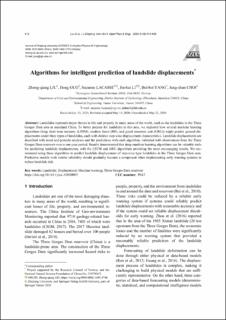| dc.contributor.author | Liu, Zhongqiang | |
| dc.contributor.author | Guo, Dong | |
| dc.contributor.author | Lacasse, Suzanne | |
| dc.contributor.author | Li, Jin-hui | |
| dc.contributor.author | Yang, Beibei | |
| dc.contributor.author | Choi, Jung Chan | |
| dc.date.accessioned | 2020-06-23T08:35:21Z | |
| dc.date.available | 2020-06-23T08:35:21Z | |
| dc.date.created | 2020-06-15T09:25:26Z | |
| dc.date.issued | 2020 | |
| dc.identifier.citation | Journal of Zhejiang University: Science A. 2020, 21 (6), 412-429. | |
| dc.identifier.issn | 1673-565X | |
| dc.identifier.uri | https://hdl.handle.net/11250/2659106 | |
| dc.description.abstract | Landslides represent major threats to life and property in many areas of the world, such as the landslides in the Three Gorges Dam area in mainland China. To better prepare for landslides in this area, we explored how several machine learning algorithms (long short term memory (LSTM), random forest (RF), and gated recurrent unit (GRU)) might predict ground displacements under three types of landslides, each with distinct step-wise displacement characteristics. Landslide displacements are described with trend and periodic analyses and the predictions with each algorithm, validated with observations from the Three Gorges Dam reservoir over a one-year period. Results demonstrated that deep machine learning algorithms can be valuable tools for predicting landslide displacements, with the LSTM and GRU algorithms providing the most encouraging results. We recommend using these algorithms to predict landslide displacement of step-wise type landslides in the Three Gorges Dam area. Predictive models with similar reliability should gradually become a component when implementing early warning systems to reduce landslide risk. | |
| dc.language.iso | eng | |
| dc.title | Algorithms for intelligent prediction of landslide displacements | |
| dc.type | Peer reviewed | |
| dc.type | Journal article | |
| dc.description.version | publishedVersion | |
| dc.source.pagenumber | 412-429 | |
| dc.source.volume | 21 | |
| dc.source.journal | Journal of Zhejiang University: Science A | |
| dc.source.issue | 6 | |
| dc.identifier.doi | 10.1631/jzus.A2000005 | |
| dc.identifier.cristin | 1815419 | |
| dc.relation.project | Norges forskningsråd: 51979067 | |
| cristin.ispublished | true | |
| cristin.fulltext | original | |
| cristin.qualitycode | 1 | |
